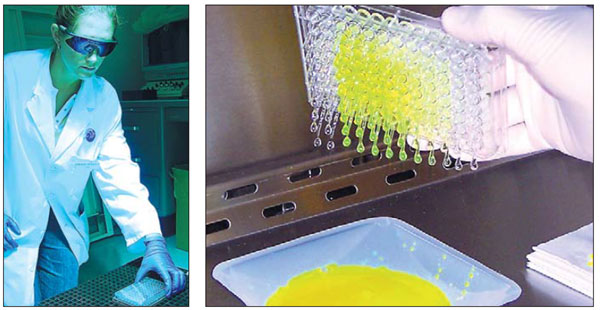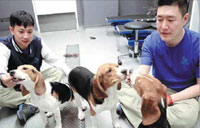 |
|
Researchers at the Institute for In Vitro Sciences in the United States conduct a phototoxicity test on cosmetic products using the in vitro methods. Provided to China Daily |
 |
| Tightening leash on testing on animals |
| Get beautiful without harming animals |
Zhang Quanshun, a senior scientist and program manager with the Institute for In Vitro Sciences in the United States, said it could take a long time for Chinese laboratories to change the way they conduct research. "Undoubtedly, the country's cosmetics industry has undergone robust growth, yet in terms of testing methods and technology, it still lags far behind," he said.
According to Zhang, only two Chinese cosmetics companies have the ability to produce 3D cultures - artificially created environments that allow cells to grow and interact with the environment in all three dimensions - for testing, while in the US there is a whole industry chain. "After all, the priority is to guarantee the safety of consumers," he said.
A late start
Compared with European countries and the United States, China had a late start in the development of in vitro methods, and the country's scientists only started researching the procedures about a decade ago, according to Cheng, who said very few scientists conducted research into alternative testing in the early part of the century.
"In recent years, these methods have attracted the attention of a growing number of researchers and labs in China, and research is slowly picking up. But compared with Western countries, there is still a huge gap," he said.
The relaxation of the test requirements for some cosmetic products has raised concerns among Chinese consumers. A number of netizens on guokr, a social networking site for science enthusiasts, wondered if the phasing out of in vivo testing would compromise product safety. "This is ridiculous. We can't test the products on animals, but should we test them on human beings instead?" wrote a netizen under the username Xenopolites.
Those concerns were dismissed by some European scientists, who said the change won't automatically mean that products will become less safe.
"In the UK, we ceased testing cosmetics on animals in 1998, and have experienced no problems as a consequence. We welcome the suggestion that China may wish to move in this direction and are happy to share our experience with colleagues there," said Judy MacArthur Clark, head of the Animals in Science Regulation Unit at the United Kingdom's Home Office.
She warned that the new testing methods would require a large amount of investment, which could present challenges for some testing centers and cosmetics manufacturers: "There will be some initial set-up costs for Chinese cosmetic companies while they retrain their staff to conduct in vitro tests. However the use of validated alternative tests will be both cheaper and faster than using animals, so the companies will benefit greatly from this saving in due course."
